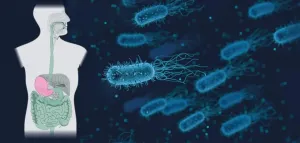Enzymatic danse macabre of lung cancer
2021-03-15
(Press-News.org) A chromatin-regulating enzyme has been shown by in-depth interdisciplinary investigations to be a key driver of a common type of lung cancer. Drugs that target the enzyme could improve treatment and survival rates for this particular cancer.
"Squamous cell carcinoma represents nearly one third of all lung cancers in humans," says KAUST structural biologist Lukasz Jaremko, who led the research along with colleagues at Stanford University and The University of Texas MD Anderson Cancer Center, U.S. "Our joint structural and dynamics investigations, including enzymatic activity studies, genetic analyses, and mouse model and human cell results, all point to the enzyme histone-lysine N-methyltransferase (NSD3) as a main driver of cancer," he says.
As part of the investigations, Ph.D. student Vladlena Kharchenko, a member of Jaremko's lab, used nuclear magnetic resonance spectroscopy to experimentally evaluate the structure and dynamics of both normal NSD3 and the hyperactive mutant implicated in driving lung squamous cell carcinoma.
"The mutation did not appear to affect the static structure of the enzyme," Kharchenko says. "However, using the dynamic nuclear Overhauser effect, we were able to show that the hyperactive mutation led to mobility changes in part of the NSD3 enzyme, enabling it to more easily catalyze the addition of two methyl molecules to a histone tail in chromatin," she explains. "This ultimately deregulates cancer-promoting genes in some forms of lung cancer."
Scientists have long been aware that many genes within a specific region on chromosome 8 are potentially involved in cancer formation. One gene in particular, FGFR1, has received much attention as a potential driver of lung cancer. But clinical trials inhibiting the protein coded by this gene have been disappointing.
"Our studies explain the molecular foundations of NSD3 enzymatic hyperactivity, its danse macabre, and unequivocally confirm that NSD3, not the previously suspected FGFR1, is the main driver of squamous cell carcinoma of the lung," says Jaremko.
The collaborative investigations also found that NSD3 was susceptible to a category of anticancer drugs called bromodomain inhibitors. But inhibitors that specifically target NSD3 are still needed, making it a prominent target for drug screening campaigns.
The team wants to improve its molecular-level understanding of the function of NSD3 in chromatin and cells. "Our study reveals that the molecular dynamics aspects of cancer research are complex and fascinating," says Kharchenko. "It also shows there is more to understand about NSD3 function at the atomic level before we can develop a potent NSD3-specific therapy."
INFORMATION:
ELSE PRESS RELEASES FROM THIS DATE:
2021-03-15
Basic, acidic, basic again: for pathogenic bacteria such as Salmonella, the human digestive tract is a sea change. So how do the bacteria manage to react to these changes? A team of researchers from the Max Planck Institute for Terrestrial Microbiology in Marburg led by Andreas Diepold has now provided a possible explanation: pathogenic bacteria can change components of their injection apparatus on the fly - like changing the tires on a moving car - to enable a rapid response.
Some of the best-known human pathogens - from the plague bacterium Yersinia pestis to the diarrhea pathogen Salmonella - use a tiny hypodermic needle to inject disease-causing ...
2021-03-15
Despite pandemic-driven restrictions on movement, there were over 12,000 accidents in Madrid in 2020, leading to 31 fatalities. In Barcelona, there were more than 5,700 collisions, causing 14 deaths. Pedestrian and vehicle safety is a priority, which is why a research project at the Universitat Oberta de Catalunya (UOC) is harnessing artificial intelligence (AI) to make decisions that will make cities safer. The researchers have looked into the correlation between the complexity of certain urban areas and the likelihood of an accident occurring there.
According to the researchers, the data they have gathered can be used to train neural networks to detect probable ...
2021-03-15
Last December, the Parliament of Catalonia unanimously approved the incorporation into its legislation of second-order violence against those who give their support to victims of violence against women. A recent study compiles testimonies of victims, and analyses this form of intimidation
To tackle violence against women, it is essential for victims to have the support of those surrounding them and to prevent them from being isolated. But what happens if the people around them are not protected? The work of Jose Ramón Flecha García, founder of the Community of Research on Excellence for All (CREA), and various academic teams, has led to the approval in the Catalan parliament of the first legislation on the Second Order of Sexual Harassment (SOSH).
The following point ...
2021-03-15
Robotics researchers are developing exoskeletons and prosthetic legs capable of thinking and moving on their own using sophisticated artificial intelligence (AI) technology.
The system combines computer vision and deep-learning AI to mimic how able-bodied people walk by seeing their surroundings and adjusting their movements.
"We're giving robotic legs vision so they can control themselves," said Brokoslaw Laschowski, a PhD candidate in systems design engineering who leads a University of Waterloo research project called ExoNet.
Exoskeletons and prosthetic devices operated by motors already exist, but users must manually ...
2021-03-15
In 2016, a collaborative group of research and education specialists received funding from the National Science Foundation for the project 'Building a Comprehensive Evolutionary History of Flagellate Plants' -- also known as 'Genealogy of Flagellate Plants' (GoFlag). Members of the team have the ambitious goal of reconstructing the 470-million-year history of one of the most diverse groups of land plants on the planet.
The first of several forthcoming publications from the project was published in a recent issue of Applications in Plant Sciences. In their inaugural article, the researchers report on the successful development of 451 nuclear target enrichment probes, which correspond to short, variable loci.
By creating a standard ...
2021-03-15
When rain began falling in northern Georgia on Sept. 15, 2009, little did Atlantans know that they would bear witness to epic flooding throughout the city. Neighborhoods, like Peachtree Hills, were submerged; Georgia's busiest expressway was underwater, as were roads and bridges; untreated sewage mingled with rising flood waters; cars and people were swept away. Then-Georgia-governor, Sonny Perdue, declared a state of emergency.
Moisture from the Gulf of Mexico fueled the flood of 2009. A decade later, Arizona State University researchers are asking whether a ...
2021-03-15
The habitats of freshwater fish species are threatened by global warming, mainly due to rising water temperatures. A 3.2-degree Celsius increase in global mean temperature would threaten more than half of the habitat for one third of all freshwater fish species. The number of species at risk is ten times smaller if warming is limited to 1.5 degrees. This is the conclusion of a study led by Radboud University, in collaboration with Utrecht University, PBL Netherlands Environmental Assessment Agency, Leiden University and others, and published in Nature Communications ...
2021-03-15
DALLAS, March 15, 2021 -- Beta-blockers treat various cardiovascular diseases and were not more likely to cause depression compared to other similar treatments, according to new research published today in Hypertension, an American Heart Association journal. While depression may occur during beta-blocker therapy, the research suggests beta-blockers are not the likely cause.
Beta-blockers are a class of medications that reduce the heart rate, the heart's workload and the heart's output of blood, which, together, lower blood pressure. They are a common treatment for cardiovascular diseases, including heart failure, arrhythmias, chest pains and high blood pressure. Researchers have suspected ...
2021-03-15
DALLAS, March 15, 2021 — Primary care clinics can play an important role in preserving patients’ brain health using the American Heart Association’s Life’s Simple 7 as a guide, as well as addressing 6 other factors associated with cognitive decline, according to a new American Stroke Association/American Heart Association Scientific Statement. “A Primary Care Agenda for Brain Health,” published today in the Associations’ journal Stroke.
Preserving brain health in an aging population is a growing concern in the U.S. An estimated one in five Americans 65 years and older has mild cognitive impairment, and one in seven has dementia. By 2050, the number of Americans with dementia is expected to triple, ...
2021-03-15
HOUSTON ? A high rate of genetic mutations within a tumor, known as high tumor mutation burden (TMB), was only useful for predicting clinical responses to immune checkpoint inhibitors in a subset of cancer types, according to a new study led by researchers from The University of Texas MD Anderson Cancer Center.
The findings, published today in Annals of Oncology, suggest that TMB status may not be reliably used as a universal biomarker for predicting immunotherapy response. While TMB status was capable of successfully predicting response to checkpoint blockade in certain cancers, such as melanoma, lung and bladder cancer, there was no association with improved outcomes in others, including breast, prostate and brain ...
LAST 30 PRESS RELEASES:
[Press-News.org] Enzymatic danse macabre of lung cancer




